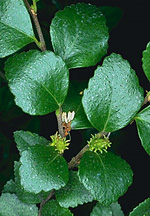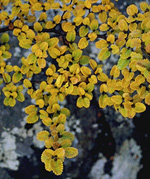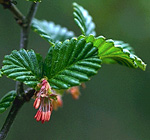 |
Most members for the family Fagaceae are northern-temperate or tropical
trees, but one genus (Nothofagus) is southern, found in Australia,
New Guinea, New Zealand and South America. In Australia several species
of Nothofagus are important trees of cool-temperate rain forests,
from Tasmania to south-east Queensland.
Characteristic features of the family Fagaceae in Australia include: - trees (or shrubs in exposed sites) with usually small, neat, simple, alternate leaves (which are winter-deciduous in the Tasmanian N. gunnii)
- flowers very small, unisexual, arranged in catkins or small clusters, with a vestigial perianth; stamens usually 6-12
- ovary inferior, with 2-3 locules; fruit a small, hard nut containing a single seed and surrounded by a cup-shaped structure formed from several bracts
Description
Evergreen trees or shrubs. Internal secretions not obvious. Plants ±glabrous, or with simple, non-glandular, unicellular hairs. Leaves alternate, spiral or distichous, petiolate. Stipules distinct and free from the petiole, scale-like or membranous, falling off early. Lamina simple, symmetric, lanceolate or ovate; base cuneate, rounded or cordate; margins serrate, ±flat; venation pinnate, with the midrib conspicuous, and the tertiary venation reticulate; surfaces punctate or not punctate; herbaceous or leathery. Male and female flowers occurring on the same plant. Inflorescences axillary, consisting of catkins, racemes, dichasial cymes or solitary flowers. Bracts present or absent. Bracteoles rarely present. Mucilaginous hairs present on buds. Pollination by wind. Flowers odourless, sessile or stalked. Floral disc absent; nectaries absent. Perianth regular, of 1 whorl only or vestigial, with 2–4 or 8–12, fused, sepaloid segments, imbricate in bud, bell-shaped, green, without contrasting markings, herbaceous. Fertile stamens 6–12 (–40), not clearly correlated with and free of the perianth segments, free of the ovary and style, distinct from each other, all ±equal. Anthers basifixed, not versatile, opening inwards by longitudinal slits, 2-celled. Ovary inferior. Carpels 2–12, fused; ovary with 2–3 locules. Style terminal, single and unbranched and the stigma capitate or decurrent on the style margins. Ovules 2 per locule, sessile; placentation axile. Fruit dry, indehiscent, nut-like (calybium); the perianth on the maturing fruit dry and persistent. Disseminule macro-surface winged; micro-surface ±smooth, brown, dull. Seeds 1 per fruit. Aril absent. Cotyledons 2. Embryo sharply bent.
(Note: this description has been generated from the coded data compiled for the key. Any errors in the key data will be reflected in the descriptions.)
A treatment of the family Fagaceae has been published in:
Flora of Australia 3: 97-100.
Australian genera of Fagaceae (as recognised for the Flora of Australia)
* = all species introduced
Nothofagus
*Quercus

|
  |

Nothofagus cunninghamii (flowers)
Photo: M.Fagg © ANBG

Nothofagus cunninghamii (flowers)
Photo: M.Fagg © M.Fagg

Nothofagus gunnii (autumn foliage)
Photo: J.Wrigley © ANBG

Nothofagus gunnii (flower)
Photo: M.Fagg © M.Fagg
|
 |
|